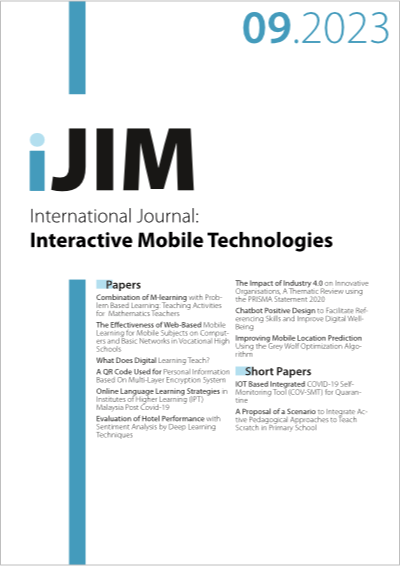IOT Based Integrated COVID-19 Self-Monitoring Tool (COV-SMT) for Quarantine
DOI:
https://doi.org/10.3991/ijim.v17i09.35505Keywords:
COVID-19, IoT, self-monitoring tool, healthAbstract
COVID-19 Self-Monitoring Tool (COV-SMT) is the research developed to address multiple issues in monitoring quarantined individuals due to COVID-19 infection. As COVID-19 is still highly infectious despite the availability of vaccines, the implementation of contactless Internet of Things (IoT) technology should be encouraged to minimize the need for medical staff to perform daily health checks and thus prevent them from being directly infected during checking. This research aims to develop an effective method to monitor quarantined individuals regarding their vital signs, such as body temperature, heart rate, and oxygen level. A contactless self-monitoring tool integrated with a stages algorithm is developed to monitor these quarantined individuals with the help of IoT technology. It can provide a consistent platform for patients or users to transfer information or data through networks, including personalized healthcare domains. COV-SMT is an effective tool to streamlet the overall process of taking measurements from quarantined individuals. It integrates multiple sensors into one tool while providing a better overall picture with its graphical presentation to help patients and medical staff better understand their health conditions.
Downloads
Published
How to Cite
Issue
Section
License
Copyright (c) 2023 Robiah Yusof, Edvin Loh Yong Loke, Gs. Dr. Othman Mohd, Ts. Erman Hamid, Ts. Haniza Nahar, Dr Fahmi Arif, Dr Suzi Iryanti Fadilah

This work is licensed under a Creative Commons Attribution 4.0 International License.
The submitting author warrants that the submission is original and that she/he is the author of the submission together with the named co-authors; to the extend the submission incorporates text passages, figures, data or other material from the work of others, the submitting author has obtained any necessary permission.
Articles in this journal are published under the Creative Commons Attribution Licence (CC-BY What does this mean?). This is to get more legal certainty about what readers can do with published articles, and thus a wider dissemination and archiving, which in turn makes publishing with this journal more valuable for you, the authors.
By submitting an article the author grants to this journal the non-exclusive right to publish it. The author retains the copyright and the publishing rights for his article without any restrictions.
This journal has been awarded the SPARC Europe Seal for Open Access Journals (What's this?)


